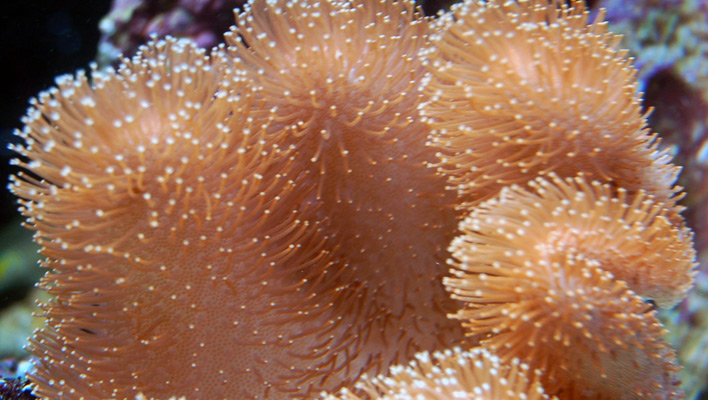The soft coral species commonly known as leather corals (various and sundry Sarcophyton, Lobophytum, Sinularia, and Alcyonium species among others) are often among the first invertebrates budding reef hobbyists select for their systems—and with good reason. The leather corals, so named for their tough, leather-like texture, tend to be extremely hardy, adaptable, and easy to grow. They may not be the most colorful corals in the ocean, but they’re attractive and interesting to observe nonetheless.
Many leather corals exhibit a particular behavior that can be alarming to hobby newcomers. That is, they occasionally retract their polyps and develop a waxy mucus coating over their tissues, which they eventually shed. This is a perfectly natural process, but when the coral is still in the contracted state, it can appear to the uninitiated hobbyist to be downright sick or even dying. However, after shedding and re-expanding, the specimen will typically look more healthy and robust than ever.
In some situations, though, leather corals will either remain in a contracted state for an inordinate amount of time or repeatedly go through the cycle of contraction and shedding with the polyps remaining extended for only brief periods. This behavior is usually an indicator that something is amiss with the physical or chemical parameters of the system.
If you should experience an expansion problem with a leather coral specimen, check for these five common causes (after first ruling out basic water-quality issues, such as the presence of ammonia or excessive nitrate):
#1: Unstable conditions
Leather corals can adapt to a broad range of aquarium conditions, provided any changes occur gradually. Like most coral reef denizens, they don’t take kindly to wildly fluctuating parameters. Your system’s water temperature, specific gravity, pH, calcium/alkalinity levels, and other parameters should be kept as stable as possible by monitoring/testing frequently and making small adjustments as needed.
#2: Photo shock
The sudden increase in light intensity following the overdue replacement of aging lamps or an upgrade to a higher-output fixture can subject your corals to photo shock, which is very stressful and can cause leather corals to contract their polyps and remain in this condition for a long period. To prevent this, be sure to replace the bulbs/tubes in your lighting fixture according to the schedule recommended by the manufacturer. When upgrading to more intense lighting, it’s a good idea to do one or a combination of the following:
- Position the light fixture higher above the tank than normal and gradually lower it over the course of several days.
- Place several layers of screening material between the lamps and the tank and gradually remove layers.
- Reduce your photoperiod (the length of time your lights are turned on each day) and incrementally return it to normal.
#3: Inadequate or excessive water movement
Leather corals need at least a moderate level of turbulent, non-linear water movement to help them shed normally and prevent the buildup of detritus on their tissues. Thus, specimens placed in water movement “dead zones” or exposed to a continuous direct blast of powerful current will be more likely to stay contracted for prolonged periods.
#4: Haphazard supplementation
With so many proprietary supplements and formulations on the market claiming to promote coral health, it’s easy to get in the habit of dosing “a little of this and a dash of that” every day with no real sense of how some of these products might affect water quality. If your leather coral refuses to expand, try eliminating nonessential supplements one at a time to see if you can determine which one(s) might be causing the problem through the process of elimination. In any case, be sure to add any supplements in strict accordance with the manufacturer’s directions.
#5: Crawling critters or coral warfare
In some cases, other organisms in the tank are the cause of the problem. For instance, because leather corals have relatively tough tissues, motile invertebrates, such as the hermit crabs so often included in reef tank cleanup crews, commonly crawl right over them. If this irritation occurs frequently enough, the coral may close up and remain contracted.
Of course, other corals in the tank may be to blame as well. A neighboring coral may be stinging the leather or exuding toxic allelopathic compounds into the water to inhibit the growth of competitors (ironically, many of the leather corals are among the most noxious in this regard).
Stinging can usually be remedied by putting more space between the competing corals, but “chemical warfare,” being an invisible process, is much more challenging to recognize and, thus, rectify. Frequent partial water changes, vigorous protein skimming, and chemical filtrants (activated carbon) are your best allies here.




honestly if you can’t keep leathers then maybe you should start with freshwater tanks
I like a fella that thinks like me but sometimes you can come across as a bit of a twat. Ha ha
As Jeff maintained, other corals may be the cause of a leather coral “discomfort”. If you keep a tank long enough (3 or 4 years is not long enough as even Supermodels can go that long without eating) you will notice cycles form. Some cycles can be hair algae, cyano, diatoms or locusts etc. I have a very old leather in my tank now that looks to be croaking. Corals exude all sorts of things into the water and they do it in relation to the moon, not the sun, so the lighting you expose your tank to at night may be as important as the light you have in the daylight. Of course no one knows this except the leather corals and they are not talking. Also resist the urge to clean your leathers with saddle soap unless you got them at the Leather Warehouse.